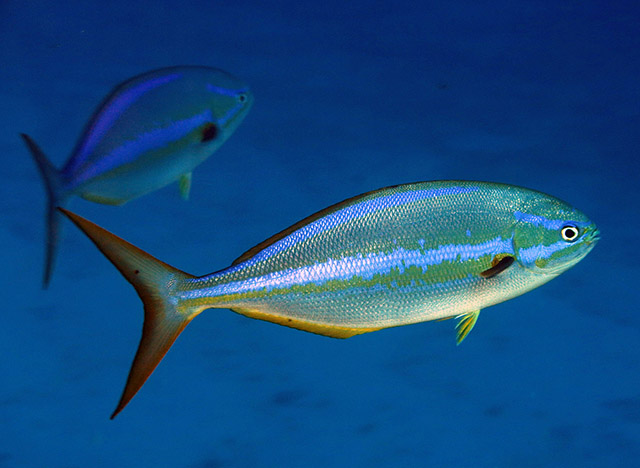| Kyphosidae (Sea chubs) |
| 59 cm TL (male/unsexed); max.weight: 2,000.0 g |
|
pelagic-oceanic; marine; depth range 1 - 20 m |
| Eastern Pacific: from Galapagos to Hawaii and across the Pacific to SE Japan, Guam and Palau, and Marquesas; possibly Micronesia. |
|
Dorsal spines (total): 11-11; Dorsal soft rays (total): 15-15; Anal spines: 3-3; Anal soft rays: 14-14; Vertebrae: 26-26. This species is distinguished by the following characters: body oval elongate, somewhat compressed; body distinctively coloured with wavy yellow and bluish stripes horizontal to the body, originating from mouth with a yellow and a blue wavy stripe stretching back to the caudal peduncle; head yellow to silvery with blue streak behind eye on operculum; metallic blue dorsally and white ventrally; caudal fin deeply forked; very low dorsal and anal fins; D XI,15; A III,14; teeth incisor-shaped: scales on interorbital region; external side of first gill arch with high number of gill rakers, 16-19 on lower limb, 7-8 on upper; total lateral line scale rows 80-85, 59-64 with pores; longitudinal scale rows 68-77; precaudal vertebrae 10, caudal 16; pterygiophores, anal 15 and dorsal 24 (Ref. 95491).
Description: head and mouth small; teeth highly characteristic, forming a single anterior row in each jaw, incisiform and somewhat lanceolate in shape, resembling the head of a golf club, their roots compressed and horizontally set, forming a striated plate inside the mouth, although this feature might be little evident; vomer toothed; fins yellowish (Ref. 55763). |
| Occurs both as solitary individuals and in schools together with K. elegans and K. vaigiensis and are found close to the surface (< 25 m) on rocky shores, the open ocean and reefs on isolated islands (Ref. 95491). Also swim rapidly in small, somewhat polarized groups or schools in open water over deep reefs, along walls and drop-offs (Ref. 5227) or usually seen near floating logs far out to sea (Ref. 11482). This species differs from its congeners in having an omnivorous diet that includes zooplankton (Ref. 95491). Not common. |
|
Not Evaluated (N.E.) Ref. (130435)
|
| harmless |
Source and more info: www.fishbase.org. For personal, classroom, and other internal use only. Not for publication.
